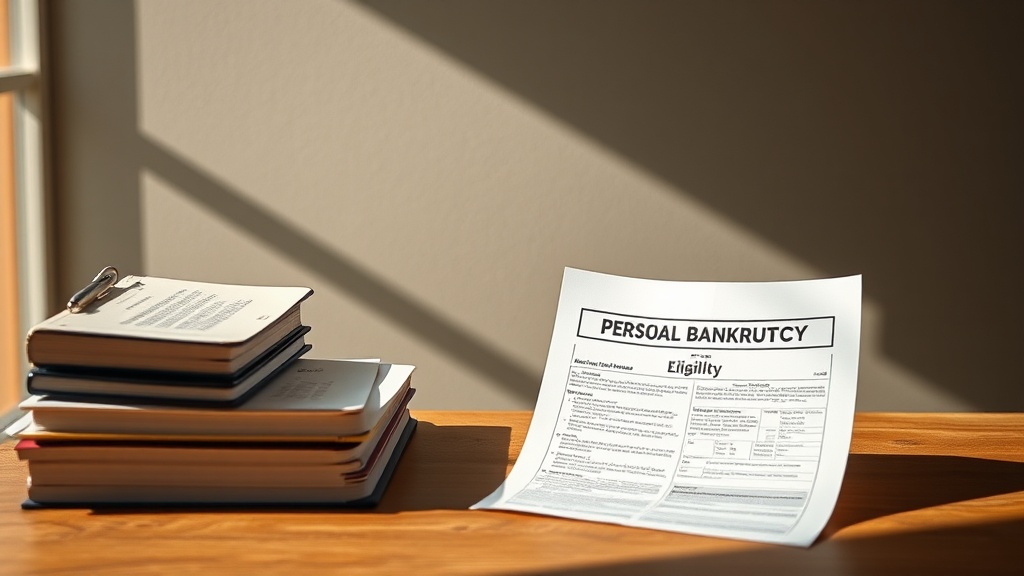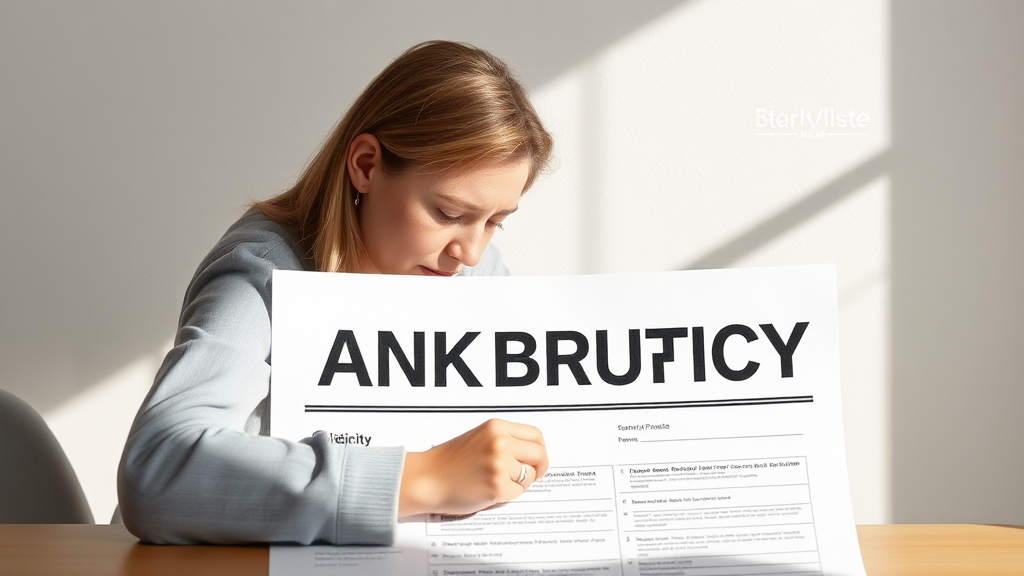Bankruptcy: Eligibility
Personal Bankruptcy in Canada Explained
bankruptcy, eligibility
To file for personal bankruptcy in Canada, you must be a resident, owe at least $1,000, and can’t meet your debt obligations. Eligibility depends on the balance between debt and income, existing assets, and any previous bankruptcies. You’ll need income statements, a list of creditors, and proof of residency. The process includes an initial consultation with a Licensed Insolvency Trustee, a formal application, and financial counseling. Common misconceptions include losing all assets and being permanently stigmatized—these are not entirely true.

Article: Eligibility for Personal Bankruptcy
Basic Requirements
Individuals must be a resident of Canada., Minimum debt threshold of $1,000., Unable to meet debt obligations as they come due.
If you're struggling with debt in Canada, knowing the basic requirements for debt relief is crucial. First and foremost, you must be a resident of Canada. This means you need to have an address within the country to qualify for various debt relief solutions, such as consumer proposals or debt consolidation programs. It's about ensuring that you have access to the resources and legal protections provided by the Canadian financial system.
The next key requirement is having a minimum debt threshold of $1,000. While this might seem like a relatively low amount, it sets the baseline for when you can start seeking formal debt relief solutions. For example, a young professional who has accumulated $1,200 in credit card debt and cannot make payments on time can explore options like negotiating with creditors or entering into a managed debt program. These solutions can provide a structured approach to get back on track.
Lastly, to qualify for debt relief, you must be unable to meet your debt obligations as they come due. This essentially means that your income isn’t sufficient to cover your debt payments along with your essential living expenses. Picture a single parent whose income barely covers rent, groceries, and utilities, leaving nothing for debt repayment. In such cases, programs like a consumer proposal or even bankruptcy might be necessary steps to regain financial stability. Understanding these basic requirements can help you identify the right moment to seek assistance and ensure you choose the most effective path to debt relief.
Eligibility Criteria
Assessment of total debt load versus income., Evaluation of existing assets and liabilities., Review of previous bankruptcy filings, if any.
Assessing your total debt load versus income is the first essential step in determining your eligibility for debt relief in Canada. This assessment helps to gauge the severity of your financial situation, identifying how much of your earnings go towards paying off debts. For example, if your monthly debt payments exceed 40% of your income, you might find it challenging to manage other essentials. This ratio, often referred to as the Debt-to-Income (DTI) ratio, helps financial advisors recommend suitable relief options, like consumer proposals or debt consolidation loans, tailored to your specific needs. Remember, the lower your DTI, the better positioned you are to handle your debt without drastic measures.
Next up, evaluating your existing assets and liabilities plays a crucial role in the eligibility criteria for debt relief in Canada. This process involves itemizing what you own—such as property, vehicles, and savings—and balancing it against what you owe. If your liabilities far outweigh your assets, it may indicate financial distress, steering you towards options like bankruptcy or consumer proposals. On the flip side, having significant assets might open doors to alternatives that protect those assets while easing your debt load. Open communication with a debt advisor can help identify the best approach, ensuring your assets are preserved as much as possible during the debt resolution process.
Lastly, reviewing any past bankruptcy filings is important, as it impacts your eligibility for certain debt relief solutions. If you’ve filed for bankruptcy before, especially within the last few years, it could limit your options and affect the terms you might be offered. For instance, having multiple prior bankruptcies could mean stricter terms or longer durations to discharge your debt. However, don’t be disheartened; even with a history of bankruptcy, there are still paths to financial recovery. By discussing your history openly with a debt counselor, you’ll uncover strategies that can help rebuild your financial standing over time.
Necessary Documentation
Income statements and employment records., List of creditors and amounts owed., Proof of Canadian residency such as government-issued ID.
If you're navigating debt relief in Canada, having the right paperwork handy can make the process smoother. First on the list is your income statements and employment records. These documents offer a clear picture of your financial situation, helping advisors tailor a plan just for you. Imagine you’re an office worker earning $60,000 a year — your pay stubs and tax returns will confirm your income and employment stability. It's like giving a doctor your full medical history so they can diagnose and treat you effectively.
Next, you’ll need a list of creditors and the amounts you owe. It’s crucial to have an accurate and comprehensive record, which could include anything from credit card statements to personal loans. For example, if you owe $5,000 to one credit card and $2,000 for an auto loan, you’ll want to list these amounts separately. This detailed inventory helps in creating a realistic repayment plan, giving you and your advisor a clear roadmap to debt freedom. Think of it as drafting a game plan — you can’t score if you don’t know where the goalposts are.
Lastly, proving your Canadian residency is essential, and this can be as simple as presenting a government-issued ID like a driver’s license or passport. This document verifies your eligibility for specific debt relief programs tailored to Canadian residents. For instance, if you just moved from another country, your proof of residency establishes your new status and opens the door to local resources designed to help. Consider this the key that unlocks all those specialized tools and services crafted to aid Canadians, making sure you’re on the right track to financial recovery.

Understanding bankruptcy eligibility criteria clearly.
Process Overview
Completion of an initial consultation with a Licensed Insolvency Trustee (LIT)., Submission of a formal bankruptcy application., Credit counseling sessions and financial literacy education.
Starting your journey towards financial stability might involve completing an initial consultation with a Licensed Insolvency Trustee (LIT). Think of the LIT as your friendly neighborhood financial expert. During this meeting, they will review your financial situation, including your assets, debts, income, and expenses, to help you understand your options. It's like having a heart-to-heart chat with someone who genuinely gets the financial pressures you're facing. They will guide you on whether bankruptcy or another debt relief solution is the right path for you.
Once you’ve had that insightful consultation, the next step could be the submission of a formal bankruptcy application if it’s deemed necessary. This stage might sound daunting, but it’s a streamlined process facilitated by your LIT. You’ll provide detailed information about your financial affairs, which might feel like writing your financial autobiography, but it’s all to ensure everything is accounted for. Your LIT makes the submission on your behalf to the Office of the Superintendent of Bankruptcy (OSB), who then kicks off the formal bankruptcy procedure, offering you a clean slate to start anew.
Financial education doesn’t stop there. After filing for bankruptcy, you’ll attend credit counseling sessions and financial literacy education. Imagine these sessions as your financial fitness boot camp. They’re designed to equip you with the tools and knowledge needed to prevent future financial pitfalls and set you on a path towards long-term financial health. Just like a personal trainer helps you with your physical health, these sessions focus on budgeting, money management, and rebuilding your credit. Embrace these sessions as an empowering step towards mastering your financial future, ensuring you’re stronger and wiser in handling your finances.
Common Misconceptions
Bankruptcy will result in loss of all personal assets—exemptions exist., Bankruptcy is a lifetime stigma—credit rebuilding is possible., High-income earners are not eligible—eligibility is based on debt and ability to pay.
One major misconception about bankruptcy in Canada is that it will result in the loss of all personal assets. This simply isn't true. There are exemptions in place to protect essential items like your home (up to a certain equity limit), personal effects, and tools of your trade. For instance, imagine Sarah, a hairstylist, who filed for bankruptcy. She feared losing her equipment and the roof over her head. Thanks to these exemptions, Sarah was able to keep the necessary tools to continue her work and even stayed in her home, alleviating a lot of her stress.
Another myth is that bankruptcy marks you with a lifetime stigma, ruining your chances of ever getting credit again. The reality is that while bankruptcy does impact your credit score, it’s far from the end of the road. Many Canadians successfully rebuild their credit within a few years by responsibly using secured credit cards and ensuring all bills are paid on time. Take John, for example, who filed for bankruptcy due to mounting medical bills. He initially thought he would never bounce back but started small, using a secured card, and eventually his credit score improved significantly.
Lastly, there’s a persistent belief that high-income earners are not eligible for bankruptcy. This is not accurate. Eligibility for bankruptcy is based on your debt level and your ability to pay it back, not your income. Picture this scenario: Lisa, a successful lawyer, found herself unable to manage her substantial debt due to a series of bad investments. Despite her high income, she qualified for bankruptcy because her liabilities far exceeded her assets and income. This showcases that bankruptcy is a viable option for anyone who finds themselves overwhelmed by debt, regardless of their earnings.
References
| Title, Source |
|---|
| Personal Bankruptcy in Canada, Government of Canada |
| Consumer Proposals and Bankruptcy, Office of the Superintendent of Bankruptcy Canada |
| Canadian Bankruptcy Requirements, BDO Canada Limited |
| Eligibility for Bankruptcy in Canada, Grant Thornton Limited |
| Common Bankruptcy Myths, Licensed Insolvency Trustees of Canada |
This article references information from the above sources.
Eliminate up to 80% of Your Debt
High cost of gas, high cost of groceries, high lending rates, low salary - being in debt is not your fault! See if you qualify for government debt programs and get out of debt today!